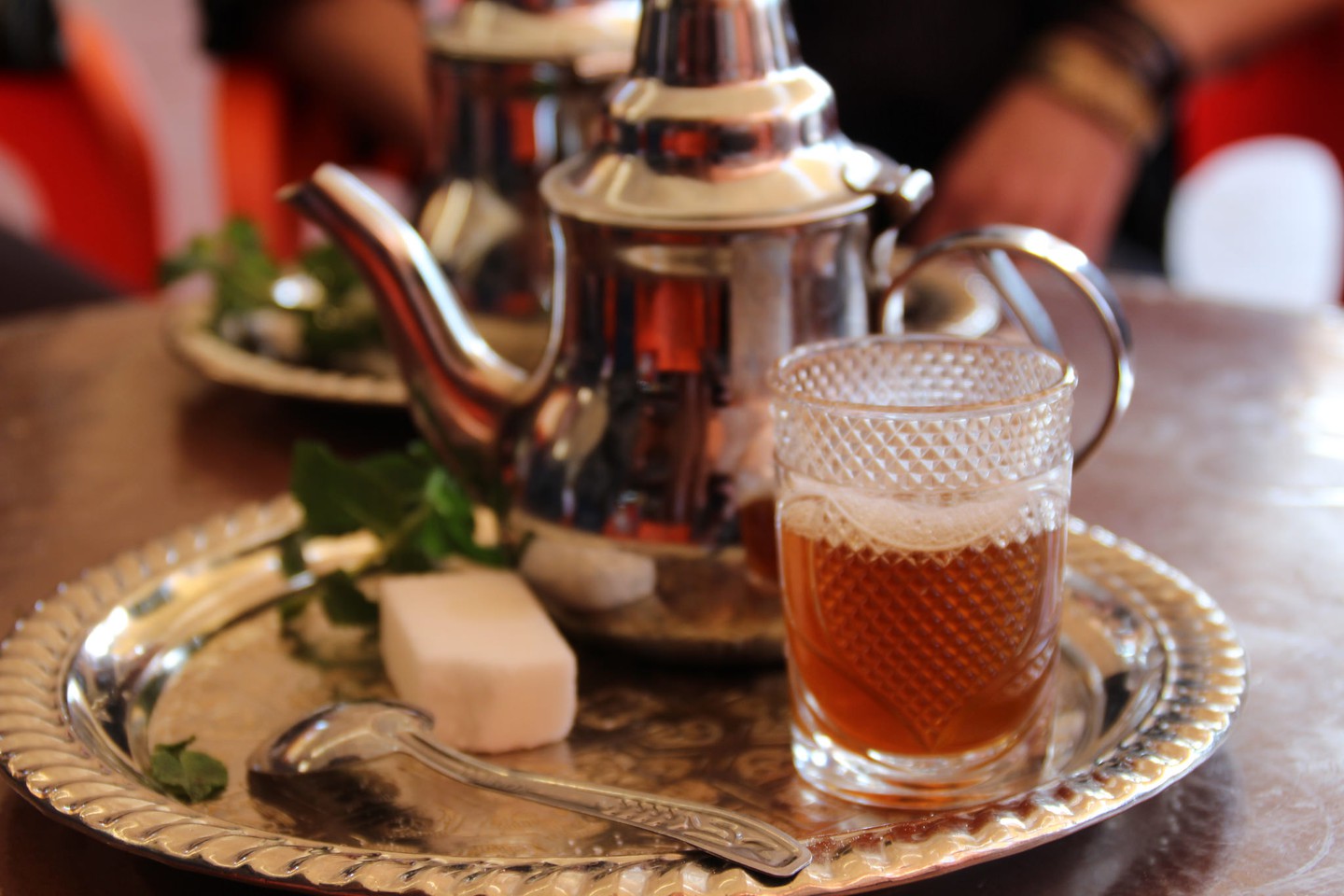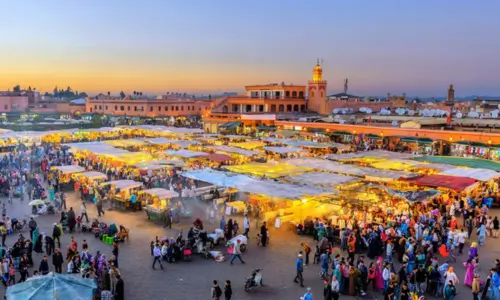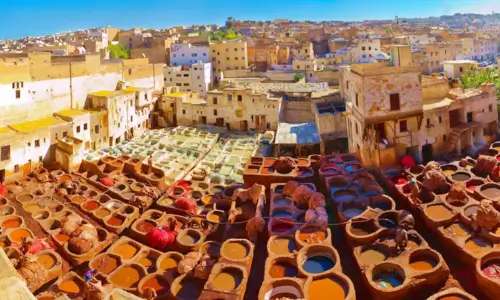Mint tea, Morocco
Tea (Arabic: أتاي, atay?) in Morocco is an essential beverage, being the largest importer of green tea in the world.
Moroccan mint tea
The herbal tea has been popular in the country long before the arrival of tea in Morocco. There are many speculations about the arrival of tea in Morocco; the main one is that King Ismail bin Sherif received green tea from Queen Anne after the release of sixty-nine British prisoners. The United Kingdom had a virtual monopoly on the tea trade in Morocco during the 19th century, especially with the renovation of the port of Essaouira in the 1760s. Tea became a widespread drink by mid-century. Mint was soon added: with its powerful flavor, it reduced the bitterness of the tea without changing its color.

History of the Moroccan mint tea
Origins of Moroccan tea
Infusions of various herbs, and in particular mint, are very popular throughout the country long before the arrival of tea in the country.
The arrival of tea in Morocco remains unclear: there are several explanations and dates for it. The first theory is that tea arrived in Morocco as early as the 11th century by the Phoenicians who settled in the north of the country for eight centuries. Another hypothesis is that the Berbers brought it with them when they arrived from the Orontes2. Abdelahad Sebti and Omar Carlier claim that the British were already selling tea in some Moroccan ports as early as the 16th century, and that the trade intensified in the following century. Another hypothesis suggests that pirates brought tea to Morocco with them. Another theory suggests that Moroccan pirates captured a ship loaded with tea during the military conquest of Spain and Portugal in the 18th century. A final, more credible theory is that the Moroccan tea trade was the result of the Spanish and Portuguese wars.
A final and more credible theory6 is that King Ismail bin Sherif received green tea from Queen Anne after the release of sixty-nine British prisoners. In 1789, the English surgeon William Lemprière, who was present at the court of Mohammed ben Abdallah, observed the tea service: it lasted at least two hours, during which the drink was served in very small quantities in tiny porcelain cups. The drink is extremely expensive and rare. It was prized mainly for its medicinal qualities and was consumed with the same utensils as in the UK.
British tea monopoly
The United Kingdom had a virtual monopoly on the tea trade in Morocco during the 19th century1 , especially with the renovation of the port of Essaouira in the 1760s. Tea became a widespread beverage by mid-century, especially in the wake of the Crimean War: unable to access the Baltic Sea ports, British traders provided an outlet for their surplus tea imports from China by creating new trading markets in Tangier and Essaouira. It was this British influence that brought the tea trade to Morocco. It was this British influence that brought to Morocco the name of tea, atay, a variant of Cantonese “tea”, as opposed to the names inspired by the Mandarin name, variants of “cha”.
Moroccan Moorish traders left Guelmim to sell British tea in the western Sahel, especially in Mali, but also in Mauritania and the rest of the region. Tea thus reached Africa via Morocco11. In 1819, Charles Cochelet reported that green tea found in Guelmim was bought by the British in Canton in exchange for opium and Spanish money. Mint was soon added: with its powerful flavor, it reduced the bitterness of the tea without changing its color. Mint tea is called “full tea,” in reference to a Moorish proverb: “tea without mint is like a meaningless tongue.”
At first, the faqīhs considered tea to be unlawful in Islam. In 1826, the faqîh Ahmed Ibn Abdelmalek Alaoui, who served as a judge, rejected the testimonies of tea drinkers, stating that “man should avoid anything of which he does not know the verdict of Allah.” The faqîh Hajj Abed El Baichouri, in the early 20th century, claims to have heard of a “tea and sugar factory in Paris where carrion bones and blood were used,” thus supporting the prohibition of tea. The Mauritanian sheikh Ahmed Hamed Ben M’hamed Ben Mukhtar Allah adds that tea leads to “mixing with slaves and youths, listening to obscene speeches and slandering people.” The discourse is quickly defeated, and many Moroccan writers defend the drink in the name of medicine and temperance. Faqîh Idriss, son of Slimane ben Mohammed, served tea to his students when he noticed their concentration waning. In 1925, Sheikh Mohammed Ben Al Mouayyad Ben Sidi wrote in a fatwa that “one should not forbid what has not been forbidden in the Qur’an, Sunna and consensus”, referring to tea consumption.
Integration of mint tea in Moroccan culture
Between 1830 and 1840, the volume of tea imported annually by Morocco increased from 3.5 to 20 tons, while its consumption spread to the urban middle class5 ; by the 1880s, it was consumed by the whole of society and tea and sugar constituted a quarter of the country’s imports6. Prices fell sharply in parallel, as European powers expanded tea cultivation in their respective colonies, increasing supply. The usage was born out of a desire to imitate the wealthier classes of Morocco, not the English: utensils imported from Britain were often stamped in Arabic to hide their imported character. At this time, there were two opposing points of view. European travelers and settlers insist on the rapid adoption of tea by all Moroccans. Local oral sources, on the other hand, stress that tea spread very slowly from one social class to another and that at first it was considered a very masculine drink.
At that time, the French protectorate of Morocco wanted to guarantee local craftsmanship. Prosper Ricard deplored the influence of European products and tried to orient the craftsmen towards the production of luxury objects: the coppersmiths worked for notables and tourists, but their market was drying up. They therefore undertook a reform of the craft, trying to copy the models of tea utensils imported from Europe, and created a corporation of swâiniya (“tray makers”) in the Fez region in the 1910s, especially in the city’s Seffarine Square. A tea-drinking ritual was introduced in Fez, which was to become the norm in the region. A ritual for drinking tea was born, as well as a whole set of utensils.
In 1946, a coppersmith introduced the mechanical lathe in the country after seeing one in Italy. Thanks to the new tool, the Et Taj company began copying the Wright teapots made in Manchester. They are now made in Fez, retaining the English shape and decorations, but with the traditional Moroccan chasing of ornaments.
In 2008, Morocco is the largest importer of Chinese green tea in the world18. In 2014, Morocco is the second largest tea consuming country, with a consumption per person per year of 4.34 kg.
Consumption Green tea with mint
Mint tea service
The tea used for mint tea, which is the most consumed tea in Morocco, is Chinese Gunpowder green tea. Moroccans add sugar loaves and handfuls of mint. Sometimes mint is accompanied by other herbs, such as wormwood, marjoram, sage or verbena: these additions are more common in winter. In March, the addition of flowers is a common practice. In March, the addition of orange blossom is common. Cactus nuts can also be used and added to the tea to resolve gastrointestinal or sleep disorders. Milk is never added. In the south of the country, saffron is sometimes added.
Aristocrats can drink amber tea. A piece of amber is wrapped in wool and placed in the opening of the teapot. The steam from the tea penetrates the wool and touches the amber. The steam, enclosed in the teapot, makes the tea taste like amber.
There is no “standard” recipe for tea, as each family uses its own brewing times and amounts of ingredients. However, there are general trends depending on the region. The Fez region produces a lighter tea, while the Berbers of the High Atlas add many herbs for a stronger flavor. In the south of the country, tea is brewed for a longer time.
The tea is brewed for a relatively long time. During the infusion process, it is stirred gently with a spoon. It is then transferred between a glass and the teapot to see the infusion level and recognize when it is ready. When the taste is satisfactory, the liquid is returned to the metal teapot and the tea is served, holding the teapot high, in small glasses, usually decorated with gold trim6. Holding the teapot so high not only serves to impress with its agility. It also serves to aerate the boiled water, helping it to cool and creating small bubbles that give a slightly different flavor to the tea.
The glasses are always half full. This allows drinkers to hold the top of the glass without burning their fingers. The decoration on the glass serves to identify at which level to stop.
A red tea box with a sugar loaf on top. On the left, a pile of mint leaves.
A half-filled glass, several empty glasses, a glass being filled with tea in which there is a lot of residue.
During the brewing process, the tea is transferred between the teapot and the glasses to remove the residue.
Utensils for the preparation of Moroccan green tea with mint
In pre-modern times, Moroccan dignitaries appreciated the use of East Asian porcelain, especially Imari porcelain. This was especially true in the 18th and 19th centuries. These porcelain tea sets were often given as gifts to wealthy families on the occasion of births and weddings, as in the rest of the Middle East. Chinese porcelain arrived long before tea: Ibn Battuta mentions it as early as the 13th century.
It is very likely that the use of porcelain cutlery in Morocco is explained by a hadîth prohibiting the eating of precious metals. The popularity of Imari porcelain in Morocco eventually became an integral part of the Islamic arts.
Mercantile relations with Europe had their own influence on tea ware. The Moroccan population saw the spread of brewed tea and the accompanying crockery: tray, teapot, glasses, sugar bowls and tea boxes16. The glasses and teapot are placed on a copper, nickel silver or silver tray. This tea tray (siniyya?) became an element of interior decoration in its own right, common to all social classes but of variable material and shape. It did not depend on an English import: it was already present in families from protohistoric times, which saw a golden age of copper production in North Africa. Metal ware was also widespread long before the arrival of tea in the region. The Algeciras Law, signed in 1906, marked the massive arrival of European objects on the Moroccan market, as European producers sought to compete with local production. At the same time, the market for tea utensils developed, allowing the brass industry in Morocco to gain in importance. At the beginning of the 20th century, it was fashionable to place the teapot, made of pewter or silver, on a silver tray. Copper teapots and samovars were also common in imports from England. Wright’s silverware, made in Manchester, entered Morocco under the name rayt; English products were often stamped in Arabic to maintain the impression that they were of local manufacture.
Under the French protectorate of Morocco, the coppersmiths set about reforming the trade, trying to copy the designs of teaware imported from Europe, and created a corporation of swâiniya (“tray makers”) in the Fez region in the 1910s, especially in the city’s Seffarine Square. At the beginning of the 19th century, they numbered about sixty; in 2011, they sometimes reached 10,000 artisans in nearly 600 factories in Fez.
In 1946, after the introduction of the mechanical lathe, the Et Taj company began copying Wright teapots. They are now manufactured in Fez, retaining the English shape and decorations, but with the traditional Moroccan chasing of decorations.
Composition
The equipment is differentiated between the richest, who have dedicated utensils, and the working classes without dedicated utensils. However, it always includes a large tray, a small tray where the tea, sugar and mint containers are placed, a teapot and glasses.
Wooden boxes are used for less wealthy families. Wealthier families may have richly decorated gold or silver boxes.
The glasses may be very richly decorated, but they should always remain partially transparent so that the tea being drunk can be seen. Their decorations also serve to identify how full the glass should be.
Occasions to drink mint tea in Morocco
Time of the day when tea is drunk in Morocco
Tea is usually served three times a day. The particularity of its service is due to the fact that the tea and mint leaves are kept in the teapot and continue to brew. As the tea is served, the resulting drink changes in taste and appearance (light at first, balanced at the second, very astringent and bitter at the last). Traditionally, three glasses6 are drunk, symbolizing the three flavors of the quote, “Mint tea should be bitter as life, frothy as love, and sweet as death. ”
Once the tea is served, it should be sipped hot, without blowing or making noise with the mouth.
Guests
Tea is served before any negotiation or sale as a sign of hospitality. It is disrespectful to refuse it. Some families have two teas: one brand is used for daily consumption and the other for special occasions and guests19. It is very impolite to serve the tea prepared before the guest arrives, or prepared out of sight.
Family
Tea is most often prepared and served by men. In the 19th century, the patriarch would choose who would have the honor of preparing the tea5,4. Even today, in more modern households, it is usually the woman who prepares and serves the tea, the man can also do it but this is more for festive occasions with many guests (as the woman is already busy preparing the meal).
Green tea is served to children at an early age, but it limits iron absorption, which can cause health problems for babies.
Among poor families, bread and tea (Khobz wa atay?) is a common and frugal meal: bread and tea are the basis of their diet, sometimes supplemented with black olives in the north, butter and olive oil in the south, or dates in the Sahara.
Special occasions
Tea ceremonies may be held on the occasion of weddings, pilgrimages and other occasions. In this case, the person who will prepare the tea will be chosen beforehand, and sometimes even a specialist will be brought in specifically for the occasion. It is always a person of mature age and reputed for his wisdom and the quality of his tea.
On this occasion, the tea will be prepared while the sandalwood is burning. The person preparing the tea may pour a few drops of rose water or orange blossom water over the guests.
The tea used for mint green tea, which is the most commonly drunk in Morocco, is Chinese Gunpowder green tea. Therefore, tea imports are divided between this tea, which accounts for 70% of sales in the country, and the rest is Chun Mee, which has a less bitter taste and is more popular among the Tuaregs in the south of the country. The mint consumed with tea is usually sourced from the Meknes region, which is said to produce the tastiest plants.
In 2008, per capita consumption of Chinese green tea was 1.76 kg per year. In 2014, Morocco is the second largest tea consuming country, with a per capita consumption of 4.34 kg per year8. There are few reliable statistics on actual tea consumption, according to Moroccan economists, so consumption is measured by import volumes.
Quantity of tea consumed in Morocco
In the 1970s, an attempt was made to grow tea in the Larache region, but it proved more expensive than importing and the experiment was abandoned. In 2020, due to the Covid-19 pandemic in Morocco and China that affected imports and tea demand, the Moroccan Association of Tea and Coffee Manufacturers asked its ministry to encourage the resumption of cultivation experiments with the aim of covering 20% of the country’s needs.
Tea imports into Morocco
Chinese Gunpowder tea
Thus, Morocco is the world’s leading importer of Chinese green tea, at least from 2008 to 201818 , ahead of Uzbekistan, Togo, Japan and the United States, accounting for 17% of China’s green tea exports in 2016 in terms of volume31 and 30% in 201932. The Chinese market accounts for 85-95% of the country’s imported green tea, with the remainder coming from Sri Lanka and India18. In the first quarter of 2020, due to the Covid-19 pandemic in Morocco and China, Chinese tea imports fell by 46% .
After the nationalization of tea imports in 1958, the market was liberalized in 1993. Prior to this liberalization, Somathes had a 95% market share, which dropped to 35% in the early 1990s35. In 2018, the Office national de sécurité sanitaire des produits alimentaires declared that it was systematically monitoring imported teas. The following year, it introduced a new system for monitoring tea imports. The following year, it introduced new sanitary standards for tea imported from China.
These standards are the result of an audit that showed that teas sold in Morocco often contain high levels of pesticides and set maximum measures, which several trade groups considered too strict. Tea is usually packaged in bulk and not sold to consumers.
Tea is usually packaged in bulk and very rarely sold in bags, but in the second half of the 2010s this form of packaging is gaining popularity.
Tea brands in Morocco
There are about 400 tea brands in Morocco, marketed by about 100 groups. Many brands are regional and rural.
The tea import market is dominated by Somathes (formerly ONTS, Office National du Thé et du Sucre) and Mido Food Company (formerly Haj Hassan Raji35), which together hold 55% of imports. The market is also dominated by Mido Food Company, which holds the largest share of tea imports. In 2018, Mido Food Companies, now again Haj Hassan Raji, is the largest group in the country. It is followed by the Bellakhdar Group, owner of the Lion brand, and the Astaib Group. It is followed by the Zine, Somathes (10% of the market) and Salman groups, with these six brands accounting for 80% of the market36. In the 2010s, new groups emerged: the Novatis group of the Badaa family, whose main brand is Taj Bladi, and the Astaïb group, owner of the Bellar and Loubane brands, which bought the Kamanja brand from the Belafqih group. In 2017, Moncef Belkhayat launched the Miaz brand with his Salman Tea group. One year later, the company represents 4% of the market.
Somathes owns the Souiri, Kafila and Menara brands, which accounted for 70% of its sales in 2005 . It also owns many regional brands, such as Oudaya, sold in the North, and Tour Hassan in the Khouribga and Béni Mellal regions, as well as a luxury brand, Chaâra no 135.
The Mido Food Company owns the Sultan brand, the country’s most popular brand. Other brands in the group include Al Arche and Raïs.
The Algerian brand Khayma has strong sales in the east of the country due to its much lower prices than Moroccan brands.
Representations in Moroccan culture
Representations in Moroccan art
In 1895, a poet Aït Baâmrane from southwestern Morocco wrote a long poem in chleuh in which he described the aesthetics of the tea ritual as a metaphor for Moroccan society, noting in particular the inequalities between social classes and European colonial influences. In the early 1970s, the Aït Baâmrane group was the first Moroccan group to be represented in Moroccan art.
In the early 1970s, the musical group Nas al-Ghiouane performed the song As-sīniyya (“the tea tray”). Tea was used as a representation of community values, showing the loneliness of individuals in a capitalist society.
Representation of Moroccan tea at the international level
The Moroccan tea ceremony is presented as an essential element for tourists to discover the country; in advertising brochures, it is often presented as “the essence of Moroccan life and the symbol of Moroccan hospitality”. In the context of tourism, the ceremony is very standardized and often lacks authenticity, being rather a caricature of the Moroccan way of life.
DISCOVER OUR TOURS TO SAHARA DESERT IN MOROCCO

FROM MARRAKECH
Our most popular Morocco Sahara Tours . The trip from Marrakech is rich in scenery and includes an unforgettable stay in a Desert Camp.

FROM FES
A great experience starting from Fes including camel trekking and at least one night in a tented desert camp in the Merzouga Desert.

CUSTOM TOURS
Our experts can create exceptional tailor-made experiences for our clients. Contact us and we´ll plan your perfect trip in Morocco.

